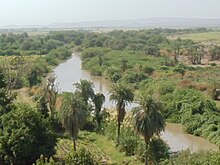Gallery forest

Agallery forestis one formed as a corridor along rivers orwetlands,projecting into landscapes that are otherwise only sparsely treed such assavannas,grasslands,ordeserts.The gallery forest maintains a more temperatemicroclimateabove the river. Defined as long and narrow forest vegetation associated with rivers, gallery forests are structurally and floristically heterogeneous.
The habitats of these forests differ from the surrounding landscapes because they are, for example, more nutrient-rich or moister and/or there is less chance of fires. The forests are sometimes only a few meters wide, because they depend on the water they lie along.
Ecology characteristics
[edit]
Theriparianzones in which they grow offer greater protection from fire which would kill treeseedlings.[1]In addition, the alluvial soils of the gallery habitat are often of higher fertility and have better drainage than the soils of the surrounding landscape with a more reliable water supply at depth. As a result, the boundary between gallery forest and the surrounding woodland or grassland is usually abrupt, with theecotonebeing only a few metres wide.[2]
Gallery forests have shrunk in extent worldwide as a result of human activities, including domestic livestock's preventing tree seedling establishment and the construction ofdamsandweirscausing flooding or interfering with natural stream flow. In addition to these disturbances, gallery forests are also threatened by many of the same processes thatthreaten savannas.Riparian zones offer protection from fire and stress fromwater shortages.In addition,alluvial soilsoffer greater fertility and better drainage, as well as greater water supply. As a result, the boundary between gallery forest and surrounding open areas is sharp and abrupt, with theecotoneonly a few meters wide.
The name "gallery" comes from an older sense of that word meaning a narrow passageway;[3]compare with "mine gallery".They are clearly identified in the landscape by sticking to the course of the river, forming a corridor or corridor completely different from the rest of the vegetation, in color and height.[4]
Areas
[edit]
Gallery forests are able to exist where the surrounding landscape does not support forests for a number of reasons. Gallery forests are often found along so-called "foreign rivers" in arid areas where no other forest grows due to the lack of water (river-accompanying gallery forest). The gallery forest is anazonalform of vegetation here, it only thrives there because of the special local conditions. Gallery forest can also form due to more favorable soil conditions on theriver bank.Examples of this are the plains of theLlanosinVenezuela,where grasses predominate despite high rainfall and only the embankments are wooded. On the plains, a hardlateritecrust in the soil, the arecife, which is hardly penetrable for roots, prevents the growth of trees. The exceptional nature of some of these forests makes them the object of special protection, such as those on the banks of theTagus RiverinAranjuez,which have been classified asWorld Heritage Sites.
Gallery forests also exist along the valleys ofOmaruru,SwakopandKuisebin the CentralNamibia.Here the riverbeds are filled with a thick layer of sand, through which groundwater flows even when there is no rain. Gallery forest in cultivated land can be found on waterbodies in pasture and farmland (e.g.alluvial forest) as well as on terrain levels (hillside forests in Europe), i.e. plots of land that are not suitable for farming. It is often the small forest as a private economic wood reserve, or unusable or inaccessible fallow land as a natural forest residue. Gallery forests have persisted inNorth Americainprairie-dominated areas along rivers and streams. In dry to temperate zones, the presence of water is not the only factor that determines species. Grassland fires, even where they are rare, have had a high selective pressure value against woody vegetation.[5]
Earlyhomininspecies such asArdipithecus ramidus,Australopithecus anamensisandHomo rudolfensishave inhabited gallery forests.
See also
[edit]- Forest-savanna mosaic
- Bosque
- Tugay
- Riparian forest
- Riparian zone restoration
- Oasis
- Swamp Oak Forests
References
[edit]- ^J. Biddulph and M. Kellman, 1998. "Fuels and fire at savanna-gallery forest boundaries in southeastern Venezuela",Journal of Tropical Ecology14:4, pp. 445–461.JSTOR2559877.
- ^J. S. Beard, 1955. "A Note on Gallery Forests",Ecology36:2, pp. 339–340.doi:10.2307/1933242.
- ^mid-15c., "covered walk or passageway, narrow and partly open passageway along a wall," from Old French galerie "a long portico" (14c.) -- Online Etymology Dictionary,https://www.etymonline.com/word/gallery
- ^Heinrich Walter, Siegmar-W. Breckle: Vegetation und Klimazonen. 7. Auflage. Verlag Eugen Ulmer, Stuttgart 1999, ISBN 3-8252-0014-0.
- ^C.-P. Hutter, K. Blessing, U. Kozina: Wälder, Hecken und Gehölze. Weitbrecht Verlag, Stuttgart 1995, ISBN 3-522-72040-7
